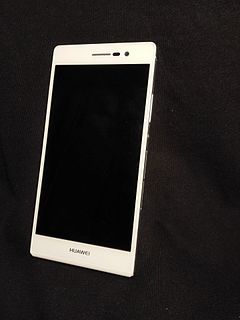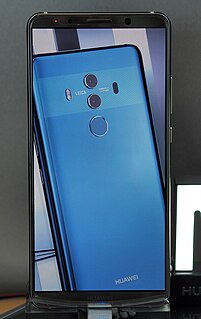The topic of this article may not meet Wikipedia's notability guidelines for products and services .(November 2015) (Learn how and when to remove this template message) |
The Huawei T261L is a mobile phone released in 2008. [1]
The topic of this article may not meet Wikipedia's notability guidelines for products and services .(November 2015) (Learn how and when to remove this template message) |
The Huawei T261L is a mobile phone released in 2008. [1]

Huawei Technologies Co., Ltd. is a Chinese multinational technology company headquartered in Shenzhen, Guangdong. It designs, develops, and sells telecommunications equipment and consumer electronics.
Huawei Ascend is the first phone in the Huawei Ascend series. It ran Android OS 2.1 by default. It has been released in the United States for Cricket Wireless and MetroPCS unsubsidized. As of the summer of 2012, the model is also available on the market in Europe.
Huawei LiteOS is a lightweight real-time operating system (RTOS) from Huawei Technologies Co., Ltd. It is an open source, POSIX compliant operating system licensed under a BSD 3-clause license for IoT smart terminals. Microcontrollers of different architectures such as ARM, x86, and RISC-V are supported by the project. Huawei LiteOS is part of Huawei's '1+2+1' Internet of Things solution, and has been featured in a number of open source development kits and industry offerings.

The Huawei Sonic is a low-range smartphone manufactured by Huawei. It is equipped with Android 2.3, a 3.2mpx camera and access to the Internet. Radio services are also provided, unlike a Nexus, with an FM radio.
Huawei Ascend G300 is a budget smartphone made by Huawei. It went on sale in April 2012 exclusively to Vodafone UK.
The Huawei Ascend P2 is a smartphone manufactured by Huawei. It was released in 2013. It is claimed to be the world's fastest smartphone. China's Huawei claimed that this device is the fastest in its own niche. According to the company it would use LTE category 4 to achieve network speeds up to 150Mbit/s. It comes with a 4.7 inch high definition screen with a powerful 1.5 GHz quad-core processor. It is sharp-cornered and its body is thinner than a pencil at 8.4 mm. Huawei announced that the Ascend P2 Android smartphone would launch in UK in June, 2013. It is available worldwide during July–September, i.e. the third quarter of 2013.
HiSilicon is a Chinese fabless semiconductor company based in Shenzhen, Guangdong and wholly owned by Huawei. HiSilicon purchases licenses for CPU designs from ARM Holdings, including the ARM Cortex-A9 MPCore, ARM Cortex-M3, ARM Cortex-A7 MPCore, ARM Cortex-A15 MPCore, ARM Cortex-A53, ARM Cortex-A57 and also for their Mali graphics cores. HiSilicon has also purchased licenses from Vivante Corporation for their GC4000 graphics core.

The Huawei STREAM X GL07S is a mobile phone manufactured by Huawei, Inc..
Huawei Ascend Mate 2 4G is an Android smartphone manufactured by Huawei as part of the Huawei Mate series. A successor to the original Huawei Ascend Mate phablet unveiled in 2013, it has a revised design with a thinner build than its predecessor, adds support for LTE, and the ability to charge other USB devices with its own battery.

The Huawei P8 is a high-end Android smartphone produced by Huawei. It was originally released in April 2015, alongside two different versions:
The Huawei T161L is a mobile phone released in 2008.

The Huawei Ascend P7 is a high-end smartphone by Huawei running the Android operating system. It was announced in May 2014 and released in June 2014. It received mixed to positive reviews, with most critics noting the slim glass construction, good front camera quality, and slow processor.
The Huawei Honor 5X is a mid-range Android smartphone manufactured by Huawei as part of the Huawei Honor X series. It uses the Qualcomm Snapdragon 616 processor and an aluminum body design. It was first released in China in October 2015, and was released in the United States and India in January 2016.
The Huawei Mate series is a line of high-end Android-powered phablet smartphones produced by Huawei, and is one of the flagship smartphones along with the P series. Since 2016, Huawei has been in a co-engineering partnership with the German manufacturer Leica, whose lenses have subsequently been used on the Mate series.

The Huawei Mate 10, Huawei Mate 10 Pro and Huawei Mate 10 Lite are Android smartphones designed and marketed by Huawei as part of the Huawei Mate series. There is also a Mate 10 Porsche design, which has 256Gb of storage but is otherwise identical to the Mate 10 Pro. They were first released on 16 October 2017. Versus the predecessor Mate 9, the Mate 10 pro flagship phone has a faster processor with an integrated neural processing unit, a slightly larger OLED screen (6.0") with a taller 18:9 aspect ratio, a significantly longer battery life and a glass back construction. Chinese and international models are available in dual SIM configuration. It comes with Android 8 and a newer version of Huawei's EMUI interface. All Mate 10 models are unlocked and GSM only. Huawei phones, including the Mate series, are not sold or financed through U.S. carriers due to pressure from U.S. intelligence agencies, though they are available from independent and online retailers.

Huawei P30 is a line of Android-based smartphones manufactured by Huawei. Unveiled on 26 March 2019, they succeed the Huawei P20 in the company's P series line.
HarmonyOS is a family of operating systems developed by Huawei. It is an Operating System designed for smart devices such as smart TVs and it has been used as a mobile operating system. It is expected to become an open-source, free, and microkernel-based distributed operating system.

Huawei Mate 30 is a line of Android-based phablets manufactured by Huawei as part of its Huawei Mate series, and the successor to the Mate 20. The Mate 30 comprises the Mate 30/5G, Mate 30 Pro/5G, and Mate 30 RS Porsche Design, which were unveiled on 19 September 2019 in Munich, Germany.
The Huawei Mate X2 is an Android-based high end foldable smartphone produced by Huawei. The phone, unveiled on 22 February 2021, serves as the successor to the Mate X and Mate Xs. The phone was vastly redesigned from the previous generation, adopting a dual-screen design very similar to the Samsung Galaxy Z Fold 2.